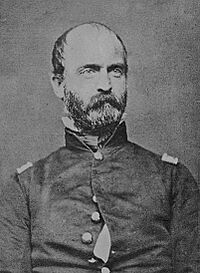Lewis Armistead facts for kids
Quick facts for kids
Lewis Armistead
|
|
|---|---|

Armistead, c. 1861–1863
|
|
| Nickname(s) | "Lo" |
| Born | February 18, 1817 New Bern, North Carolina, U.S. |
| Died | July 5, 1863 (aged 46) Gettysburg, Pennsylvania, U.S. |
| Buried |
Old Saint Paul's Cemetery
Baltimore, Maryland |
| Allegiance | |
| Service/ |
|
| Years of service | 1839–61 (USA) 1861–63 (CSA) |
| Rank | |
| Unit | 6th U.S. Infantry |
| Commands held | 57th Virginia Infantry Armistead's Bde, Pickett's Div, I Corps |
| Battles/wars | |
| Relations |
|
Lewis Addison Armistead (born February 18, 1817 – died July 5, 1863) was an officer in the United States Army. He later became a brigadier general in the Confederate States Army during the American Civil War. On July 3, 1863, Armistead led his soldiers in a famous attack called Pickett's Charge. This happened during the Battle of Gettysburg. His brigade reached the farthest point of the Confederate attack, known as the high-water mark of the Confederacy. However, his men were outnumbered, and he was wounded and captured. He died in a hospital two days later.
Contents
Early Life and Family History
Armistead was born in New Bern, North Carolina. His friends called him "Lo." He came from a very respected military family. His father, Walker Keith Armistead, was one of five brothers who fought in the War of 1812. His uncle, Major George Armistead, was in charge of Fort McHenry during the Battle of Baltimore. This battle inspired the song "The Star-Spangled Banner," which became the U.S. national anthem.
Armistead went to the United States Military Academy at West Point. He joined in 1833 but left soon after. He rejoined in 1834 but had trouble with his studies. In 1836, he left West Point for good after an incident with another cadet.
His father helped him get a job as a second lieutenant in the 6th U.S. Infantry in 1839. He was promoted to first lieutenant in 1844. Armistead married Cecelia Lee Love in 1844. She was a distant cousin of Robert E. Lee. They had two children, Walker Keith Armistead and Flora Lee Armistead.
Military Service and Personal Challenges
Armistead served in the Mexican–American War. He was recognized for his bravery in battles like Contreras and Churubusco. He was wounded at the Battle of Chapultepec. He was promoted to brevet major for his actions in these battles.
After the Mexican War, Armistead continued his military career. He was stationed in different places. In 1850, his young daughter, Flora Love, passed away. Later that year, his first wife, Cecelia, also died. In 1853, Armistead married his second wife, Cornelia Taliaferro Jamison. They had one child, Lewis B. Armistead, who also died young. Cornelia passed away in 1855 during a cholera outbreak.
Between 1855 and 1858, Armistead served at various military posts in the western United States. In 1858, his regiment was sent to Utah. Later, they were sent to California. His regiment was then involved in the Mohave War against the Mohave people along the Colorado River. Armistead was left in command of a new post, which he named Fort Mojave. After some fighting, the Mohave people made peace.
The Civil War and Gettysburg

When the Civil War began, Captain Armistead was stationed in San Diego. He was a close friend of Winfield Scott Hancock, who would become a Union general. Before leaving to join the Confederate army, Armistead told Hancock, "Goodbye; you can never know what this has cost me." This showed how hard it was for friends to choose sides in the war.
Armistead traveled east and became a colonel of the 57th Virginia Infantry. He fought in several important battles. These included Seven Pines, the Seven Days Battles (where he led an attack at Malvern Hill), and Second Battle of Bull Run. At the Battle of Antietam, he worked as Robert E. Lee's provost marshal, dealing with soldiers who left the army without permission. He also fought at Fredericksburg.
Armistead's brigade arrived at the Battle of Gettysburg on the evening of July 2, 1863. The next day, July 3, he was badly wounded while leading his brigade in Pickett's Charge. Armistead led his men from the front, waving his hat on his sword. His brigade reached the stone wall at The Angle, which was the goal of the attack. This was the farthest point reached by Confederate soldiers in the charge, known as the high-water mark of the Confederacy. However, Union soldiers quickly fought back. Armistead was shot three times after crossing the wall.
Union Captain Henry H. Bingham found Armistead and took his personal items. Bingham also told Union Major General Winfield Hancock, Armistead's old friend, about his injuries. Armistead's wounds were not thought to be deadly at first. He was shot in his arm and leg. He was taken to a Union hospital at the George Spangler Farm. However, he died two days later. Doctors believed he died from an infection and fever, not directly from the bullet wounds.
Lewis Armistead is buried next to his uncle, Lieutenant Colonel George Armistead, in Old Saint Paul's Cemetery in Baltimore, Maryland.
Legacy and Tributes
Armistead's sword was given back to the South at a meeting of Civil War veterans in Gettysburg in 1906.
His death is remembered at the Friend to Friend Masonic Memorial on the Gettysburg Battlefield. This memorial was dedicated in 1994.
In Popular Culture
Lewis Armistead has been shown in several movies and books.
- In Gettysburg, a movie based on the novel The Killer Angels, Armistead was played by actor Richard Jordan.
- Actor John Prosky played Armistead in Gods and Generals.
- Armistead is also a character in the book Gettysburg: A Novel of the Civil War (2003) by Newt Gingrich and William Forstchen.
See also

